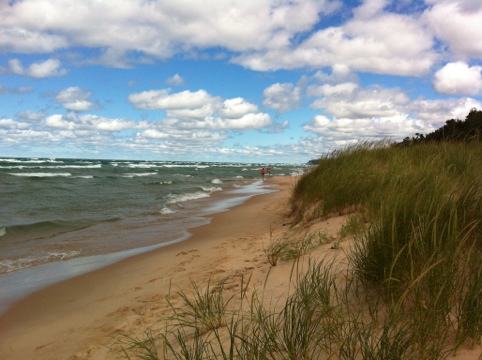Over at Circle of Blue, we’ve spent much of the year reporting on the transition occurring in the Great Lakes as a result of changes in climate and energy markets. The newest article, on shifting water levels and the Great Lakes port and transport sectors, posted here today.
On average, two big ships call every day at the docks of this Lake Erie city. The route to one of the busiest ports in the Great Lakes follows a 34-kilometer (21-mile) ship channel, which starts well out in Lake Erie, runs past the Maumee River delta, and ends 11 kilometers (seven miles) upstream. To ensure the ships do not scrape the bottom of the shallow port at the mouth of the silty Maumee, the U.S. Army Corps of Engineers annually dredges 700,000 cubic meters (900,000 cubic yards) of mud and sand from the channel, or 1 million metric tons a year.
For decades, the mathematics of waterborne transport here were simple. For every 10 to 11 metric tons of cargo that moved into and out of the Toledo port, about one metric ton of sediment left the channel. (Last year, 10.4 million metric tons of cargo were handled at the port.)
This all equates to more frequent dredging to keep transportation flowing on the Great Lakes. Tens of millions of dollars in Great Lakes port planning and construction depend on a better understanding of weather and water conditions over the next several decades. Tens of billions of dollars in waterborne trade do, as well.
Port Planning in Era of Climate Change
“We’re not in the business of speculating about climate change or its causes,†said Glen Nekvasil, vice president of the Lake Carriers Association, the trade group of U.S. flagged vessels, which is based in Cleveland, Ohio. “We’re just seeing a lot of variability in water levels, and it affects our operations.â€
On Tuesday morning next week, August 21, Circle of Blue hosts a conference call with the media and citizens to discuss the findings of the new Great Lakes report. Join us by signing up here:
Essentially, our reporting found that the Great Lakes and Great Lakes states are in the midst of a remarkable and confounding ecological and economic transition related to climate change and the fossil energy sector. Real and swift changes are occurring on waterways carrying less coal, pipelines transporting more corrosive fuels, refineries expanding and modernizing, coal plants shutting down, and natural gas wells supplying more gas-fired power plants. The shift in fuel sources has helped to reduce air emissions, but also increased water pollution events. It’s also helped Ohio, Indiana, and Michigan become top generators of new jobs over the past year.
Meanwhile, the effects of climate change and erratic weather appear to be eroding infrastructure at big ports, and influencing waterborne transport as Great Lakes water levels drop. Sediment levels are increasing. Ships carry lighter loads. Docks and other infrastructure are decaying. A wealth of new science also is revealing disturbing trends about the effects of warming air and water on the intensity of storms, ice cover, erosion, stormwater overflows, sea lamprey reproduction, and other events.
Join our interactive conference call with Circle of Blue’s director, J. Carl Ganter, myself, and three prominent Great Lakes authorities, to ask questions, learn more, and sort out seminal trends that are shaping the Great Lakes.
— Keith Schneider
